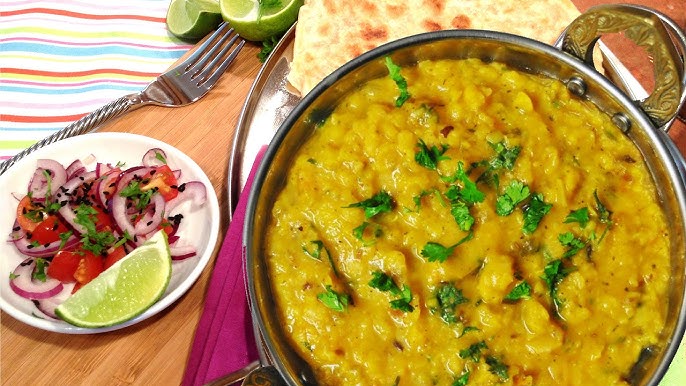Lentil Curry Recipe: Lentil curry, often referred to as “dal curry” in South Asia, is one of those dishes that feels like a warm hug in a bowl. It’s wholesome, filling, and bursting with flavor. This dish has been around for centuries and continues to be a favorite in homes across the world because it’s budget-friendly, highly nutritious, and easy to prepare. Whether you’re a busy student, a home cook feeding a family, or someone who wants a satisfying plant-based meal, lentil curry is the answer.
Why Lentil Curry is a Comfort Food
Think of a dish that brings both nostalgia and nourishment—lentil curry does exactly that. For many cultures, especially in India, Pakistan, and Nepal, dal is the centerpiece of everyday meals. It’s hearty without being heavy, and the gentle blend of spices makes it deeply comforting. A warm bowl of lentil curry paired with rice or bread is the ultimate definition of soul food. Unlike fast food that leaves you sluggish, lentil curry energizes your body while calming your mind.
A Healthy, Protein-Packed Meal
One of the biggest reasons lentil curry has gained popularity beyond its traditional roots is its nutritional value. Lentils are little powerhouses packed with plant-based protein, fiber, and essential vitamins. If you’re vegetarian or vegan, this dish is one of the easiest ways to meet your protein requirements without relying on meat. Plus, the spices like turmeric, cumin, and ginger not only add flavor but also provide incredible health benefits such as reducing inflammation and boosting immunity. It’s truly a dish where taste and health go hand in hand.
Ingredients You’ll Need
The beauty of lentil curry is that it uses simple pantry ingredients yet creates an explosion of flavors. Depending on your style of cooking, you can keep it minimal or go all out with aromatics and spices.
Core Ingredients for the Curry
Here’s a list of basic ingredients you’ll need for a classic lentil curry:
- Lentils (1 cup) – Red lentils cook faster, while green or brown lentils give more texture.
- Onion (1 medium, finely chopped) – Adds depth and sweetness.
- Tomatoes (2 medium, chopped or pureed) – Gives body and tanginess.
- Garlic (4 cloves, minced) – Essential for the flavor base.
- Ginger (1-inch piece, grated) – Adds warmth and aroma.
- Spices – Turmeric, cumin, coriander powder, chili powder, and garam masala.
- Oil or Ghee (2 tablespoons) – For sautéing the aromatics.
- Water or Vegetable Broth (3–4 cups) – For cooking lentils and adjusting consistency.
- Salt (to taste)
Optional Ingredients to Enhance Flavor
- Coconut Milk – For a creamy, Thai-inspired curry.
- Green Chilies – If you love extra heat.
- Fresh Cilantro – For garnishing.
- Lemon Juice – A squeeze at the end brightens the flavors.
- Spinach or Kale – For an extra boost of nutrition.
Choosing the Right Lentils
Not all lentils cook the same way, so it’s important to pick the right type for your curry:
- Red Lentils (Masoor Dal): Cook quickly, perfect for a smooth, creamy curry.
- Yellow Lentils (Moong Dal): Light and easy to digest, ideal for everyday meals.
- Green or Brown Lentils: Hold their shape well, great if you prefer a chunkier curry.
- Black Lentils (Urad Dal): Rich and earthy, commonly used in North Indian cuisine.
Preparing for the Recipe
Cooking lentil curry doesn’t have to be complicated, but a little preparation goes a long way in ensuring the dish turns out perfect.
Tips for Washing and Soaking Lentils
Before you start cooking, always rinse lentils thoroughly under running water until the water runs clear. This helps remove excess starch and prevents the curry from becoming too gummy. Some lentils, like green or brown, benefit from soaking for 20–30 minutes, which reduces cooking time and improves digestibility. Red lentils, on the other hand, usually don’t require soaking and cook quickly.
Prepping Vegetables and Spices
Chopping onions, tomatoes, garlic, and ginger beforehand makes the cooking process smoother. Keep your spices measured and ready in small bowls—it saves time and prevents mistakes like adding too much chili powder in a rush. If you’re using fresh herbs like cilantro, wash and chop them in advance so you can sprinkle them over the curry right before serving.
Cooking Equipment You’ll Need
- Heavy-bottom pot or Dutch oven – Helps distribute heat evenly.
- Wooden spoon or spatula – For stirring the curry.
- Blender (optional) – If you prefer a smooth curry base.
- Pressure cooker or Instant Pot – A lifesaver for cooking lentils quickly.
Step-by-Step Guide to Cooking Lentil Curry
Now that you’re prepared, let’s dive into the actual cooking process. This is where the magic happens, and every step adds another layer of flavor to your curry.
Step 1 – Cooking the Lentils
Start by rinsing your lentils thoroughly. Place them in a pot with water or broth and bring to a boil. Skim off any foam that rises to the surface—it’s natural but can make the curry cloudy. Lower the heat and let them simmer until soft but not mushy. Red lentils usually take 15–20 minutes, while green or brown lentils may take 30–40 minutes.
Step 2 – Preparing the Curry Base
While the lentils cook, heat oil or ghee in a separate pan. Add finely chopped onions and sauté until golden brown. This step is crucial because caramelized onions add depth of flavor. Next, add garlic and ginger, cooking until fragrant. Stir in spices—turmeric, cumin, coriander, and chili powder—and let them bloom in the hot oil for a few seconds before adding chopped tomatoes. Cook until the tomatoes break down into a thick sauce.
Step 3 – Combining Lentils and Curry Sauce
Once your lentils are tender, add the curry base to the pot of lentils. Stir well to combine. This is when your kitchen will start smelling heavenly. Taste the curry and adjust salt and spices according to preference.
Step 4 – Simmering and Adjusting Spices
Let the curry simmer for another 10–15 minutes. This allows all the flavors to meld beautifully. If the curry feels too thick, add more water or broth. For creaminess, stir in coconut milk at this stage. Taste again and adjust with lemon juice or extra spices if needed.
Step 5 – Garnishing and Serving
Turn off the heat and sprinkle fresh cilantro on top. You can also drizzle a little ghee or coconut cream for extra richness. Serve hot with steamed rice, naan, or chapati.
Variations of Lentil Curry
The best thing about lentil curry is its versatility. You can make it in dozens of ways depending on the ingredients you have on hand or the type of flavors you crave. Here are some delicious variations you should try.
Indian-Style Lentil Curry (Dal)
This is the most traditional version and probably the one you’ll find in most Indian households. Dal is usually made with yellow or red lentils, flavored with onions, tomatoes, ginger, garlic, and a simple spice mix. What makes Indian dal unique is the “tadka” or tempering. This is when whole spices like cumin seeds, mustard seeds, dried red chilies, and curry leaves are fried in hot ghee or oil and poured over the cooked lentils. It adds an irresistible aroma and a burst of flavor that makes the dish truly authentic.
Another interesting twist in Indian dal is the use of regional variations. In South India, lentil curry often includes tamarind for a tangy flavor, while in North India, it might be richer with cream or butter. So if you want a taste of true Indian comfort food, stick with the classic dal and don’t skip the tadka—it’s the soul of the dish.
Thai-Inspired Lentil Curry
If you’re in the mood for something exotic, try a Thai version of lentil curry. Instead of traditional Indian spices, this variation uses Thai curry paste—red, green, or yellow, depending on your preference. Coconut milk forms the base of the sauce, giving it a creamy texture and slightly sweet flavor. Fresh lemongrass, kaffir lime leaves, and Thai basil can also be added to bring authentic Thai aromas to the dish.
This type of lentil curry pairs beautifully with jasmine rice and feels lighter than the traditional version. If you want a blend of comfort and freshness, Thai-style lentil curry is a must-try.
Vegan Coconut Lentil Curry
For those who love creamy curries but want to keep them completely dairy-free, coconut milk is the star ingredient. Red lentils work best in this version because they break down into a smooth texture. Add plenty of spices like turmeric, cumin, paprika, and garam masala, then finish with coconut milk for a velvety result.
The coconut milk not only enhances flavor but also balances out the heat from the spices. You can even add vegetables like spinach, zucchini, or bell peppers to make it more filling and nutrient-rich. This variation is a favorite among vegans and non-vegans alike because it’s hearty, satisfying, and delicious.
Tips for Perfect Lentil Curry Every Time
Even though lentil curry is a simple dish, a few little details can take it from good to absolutely amazing. Here are some tried-and-true tips for cooking the perfect lentil curry.
Balancing Spices and Flavors
The key to a great lentil curry lies in the balance of flavors. If your curry tastes too spicy, add a splash of coconut milk or yogurt to mellow it out. If it feels too bland, squeeze in some lemon juice or add a pinch of garam masala for depth. Remember, spices bloom best in hot oil, so always cook them for a few seconds before adding liquids. This prevents raw, bitter flavors and ensures maximum aroma.
Another trick is layering spices—adding some at the beginning for the base flavor and finishing with a little extra toward the end for freshness. This gives your curry a more complex, restaurant-style taste.
How to Avoid Overcooking Lentils
Nobody wants mushy lentils unless they’re intentionally making a puree-style dal. To avoid overcooking, always check your lentils a few minutes before the recommended cooking time. Different varieties cook at different speeds, so don’t just rely on the clock—taste them. They should be tender but still hold their shape.
If you’re using a pressure cooker or Instant Pot, be careful with timing. Red lentils only need about 5 minutes under pressure, while green or brown lentils may need 10–12 minutes. Release the steam promptly to avoid overcooking.
Storage and Reheating Tips
Lentil curry stores beautifully, which makes it perfect for meal prep. Once cooled, transfer it to airtight containers and refrigerate for up to 4 days. When reheating, add a splash of water or broth to loosen it up because lentils tend to thicken as they sit.
For longer storage, lentil curry can also be frozen for up to 2–3 months. Just thaw it overnight in the fridge and reheat on the stove. The flavors often deepen after a day or two, making leftovers taste even better than fresh.
What to Serve with Lentil Curry
A bowl of lentil curry on its own is satisfying, but pairing it with the right sides can elevate your meal into a complete feast.
Pairing with Rice
Rice is the classic partner for lentil curry. The mild, fluffy grains balance the bold flavors of the curry. You can choose from:
- Basmati Rice: Aromatic and long-grained, perfect for Indian-style curry.
- Jasmine Rice: Light and slightly sticky, works well with Thai-inspired curry.
- Brown Rice or Quinoa: For a healthier, high-fiber option.
Cooking your rice with a little cardamom or bay leaf also adds a subtle fragrance that complements the curry.
Serving with Bread (Naan, Chapati, Roti)
If rice isn’t your thing, flatbreads are another great option. Soft, fluffy naan is ideal for scooping up curry, while chapati and roti are lighter alternatives. Garlic naan, in particular, pairs beautifully with creamy lentil curry. You can even make parathas (layered flatbread) for a richer side dish.
Complementary Side Dishes
To create a well-rounded meal, consider serving lentil curry with sides like:
- Cucumber Raita (yogurt dip) – Cools down the heat of spices.
- Pickles (achar) – Adds tangy, spicy contrast.
- Papadum (crispy lentil crackers) – Adds crunch to the meal.
- Simple Salad – A refreshing mix of cucumber, onion, and tomato.
These small additions bring variety and texture, making your meal even more enjoyable.
Nutritional Benefits of Lentil Curry
Apart from its amazing flavor, lentil curry is a nutritional powerhouse. It’s one of the healthiest comfort foods you can make at home.
Protein and Fiber Content
Lentils are loaded with protein, making them an excellent choice for vegetarians and vegans. One cup of cooked lentils contains around 18 grams of protein, which helps repair muscles and keeps you full for longer. They’re also rich in dietary fiber, aiding digestion and promoting a healthy gut.
Vitamins and Minerals in Lentils
Lentils are packed with essential vitamins and minerals such as iron, folate, potassium, and magnesium. Iron helps in preventing anemia, folate supports healthy cell function, and potassium keeps your heart and muscles functioning properly. When paired with spices like turmeric and cumin, the dish becomes not only delicious but also medicinal.
Why It’s Great for a Balanced Diet
If you’re trying to eat healthier, lentil curry is a fantastic addition to your weekly meal plan. It’s low in fat, high in protein, gluten-free, and naturally plant-based. You can make it lighter with less oil or richer with coconut milk depending on your needs. Plus, because lentils are affordable, you can feed your family a nutritious meal without breaking the bank.
FAQs about Lentil Curry Recipe
1. Can I make lentil curry ahead of time?
Yes! In fact, the flavors deepen after a day, making it even more delicious. Store it in the fridge for up to 4 days.
2. How can I make lentil curry thicker?
Simmer it longer to reduce excess liquid, or mash some of the lentils to thicken naturally.
3. Which lentils are best for curry?
Red and yellow lentils are best for smooth curries, while green and brown lentils are great for chunkier versions.
4. Can I freeze lentil curry?
Absolutely. Store in freezer-safe containers for up to 3 months. Thaw overnight in the fridge before reheating.
5. How can I make lentil curry less spicy?
Use fewer chilies or chili powder, and add coconut milk or yogurt to balance the heat.
Conclusion
Lentil curry is one of those recipes that proves you don’t need complicated ingredients to create something delicious, nourishing, and comforting. With just a few pantry staples and some aromatic spices, you can whip up a hearty dish that’s both satisfying and healthy. Whether you stick to a traditional Indian dal, experiment with a Thai-inspired version, or go for a creamy coconut-based curry, there’s a style to suit every taste.
Once you try it, you’ll see why lentil curry is a staple across so many cultures. It’s easy to make, incredibly versatile, and perfect for both weeknight dinners and special gatherings. So grab your favorite lentils, gather your spices, and let this step-by-step guide lead you to the perfect bowl of curry.



